
image by Ivan Sache, 4 February 2009

Last modified: 2009-08-08 by dov gutterman
Keywords: education |
Links: FOTW homepage |
search |
disclaimer and copyright |
write us |
mirrors
See Also:
Other Institutions:

image by Ivan Sache, 4 February 2009
"Colegio Santa Fe" was founded in 1953 at
Valledupar, Department of Cesar.
The flag of the institute, according to a photo and the
description available on the institute
website, is horizontally divided green- white. Green
symbolizes hope while white symbolizes transparency.
Ivan Sache, 4 February 2009
"Institución Educativa 'Santa Juana de Arco'" (St.
Joan of Arc) is located at Santa María, Department of Huila.
The flag of the
institute, as shown graphically and described on the blog
of the institute, is white with three blue and yellow
fleurs-de- lis placed along the descending diagonal.
The flag, designed by Father Jairo Trujillo Polanco in 1975, is
based on Joan of Arc's [alleged] standard. White symbolizes the
purity of the saint. The fleur-de-lis, the French national flower
[sic], is a tribute to Joan of Arc's motherland.
Ivan Sache, 4 February 2009
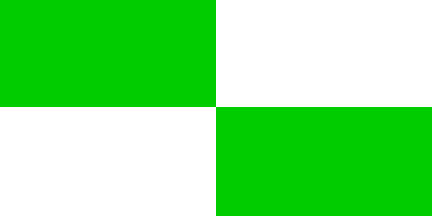
image by Ivan Sache, 9 June 2001
Colegio de Santa Librada - 1:2 (apparently), quarterly divided
green-white-white-green The flag is shown on <www.santalibrada.edu.co>,
located by Dov Gutterman.
Ivan Sache, 9 June 2001
"Colegio Distrital Santa Librada" is located at
Bogotá. The college is named after St. Librada (Liberata,
Livrade...), aka St. Wilgefortis, aka St. Uncomber, the patron
saint of women wishing to be "disuncombered" from
abusive husbands. Known as "the bearded virgin" but
without any historic background, the poor saint was removed from
the list of commemorated saints by the Roman Catholic Church in
1969.
The flag of the
institute, as shown graphically and described on the website
of the institute, is slightly higher than wide, white with an
aquamarine triangle pointing downwards charged with a white
rising sun. An alternative interpretation of the drawing is a
triangular light aquamarine flag with a white rising sun.
The sun represents light, energy, joy, commitment and solidarity
of all the members of the institute. White represents peace,
unity and the interest of the institute. Aquamarine
represents tranquillity, future, strength and commitment to study
of the students.
Ivan Sache, 18 January 2009
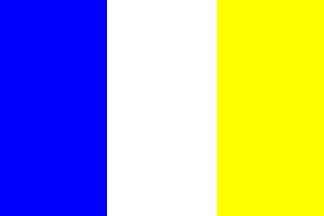
image by Ivan Sache, 5 January 2009
"Colegio Parroquial Santa Lucía" was
founded in 1987 in Floridablanca by Father Silvano Poletto,
parish priest of Santa Lucía and legal representative in
Colombia of the religious community of the "Siervos de la
Caridad" (Servants of Charity), a community founded by the
Italian priest Luis Guanella (1842-1915, blessed in 1964).
The flag of the institute, as shown graphically and described on
the website
of the institute, is vertically divided blue-white-yellow.
Blue represents the natural environment, empathy and respect of
the students for their surroundings, including humans and the
ecological environment.
White represents the light protecting the college and
enlightening our lives, as well as truth and transparency to be
attained by the students.
Yellow represents the Catholic faith and religious education.
The flag can be seen on a photo,
as presented by the band of the institute.
Ivan Sache, 5 January 2009

image by Eugene Ipavec, 22 February 2007
The Industrial University of Santander is located in
Bucaramanga. The flag is apparently available on the home page of
the university
web site.
Ron Lahav, 22 February 2007
Simple white/green bicolor; the shade of green is
specified as PANTONE 368c, CMYK 50:0:95:0, RGB 103:185: 62.
Eugene Ipavec, 22 February 2007
From university
web site, we learn the meaning of the green colour. Green is
a bright colour symbolizing hope and a chromatic sign evoking the
opening of man towards all possible constructions, utopia, the
best for society, all implicit elements in the educative task.
Ivan Sache, 30 December 2008
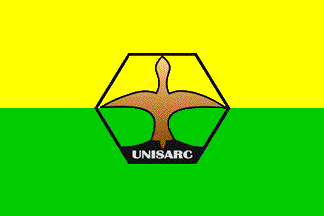
image by Ivan Sache, 17 December 2008
"Universidad Santa Rosa de Cabal" (UNISARC) is the
Colombian agronomic university. The "El Jazmin" campus
has a crop farms, a cattle farm, a fish breeding station and a
technological park.
The flag of UNISARC is shown graphically and described in the UNISARC
website.
The flag is horizontally divided yellow-green with a simplified
version of the UNISARC emblem in the middle.
The colours symbolize the balance between knowledge (represented
by yellow) and the natural environment (represented by green).
The hexagonal emblem stands for the six (economic, social,
technological, cultural, environmental and political) issues
addressed by UNISARC.
The bird, a goose displayed with spread wings, represents
progress. On the emblem, but not on the flag, red fruits placed
above the head and under the wings of the goose represent
productivity.
Ivan Sache, 17 December 2008
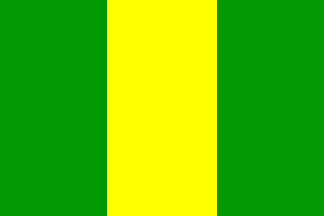
image by Ivan Sache, 31 January 2004
"Institución Educativa 'Santa Teresa de Jesús'"
was founded in 1909 or 1911 in Armenia, Department of Antioquia,
as "Colegio Oficial de Señoritas".
The flag of the institute, as described on the website
of the institute, is vertically divided green-yellow-green.
Green represents hope.
Yellow represents the resources and strength of creative
thinking.
The two green stripes also represent the natural environment
while yellow represents bright mornings, with confidence into a
future full of harmony and equity.
Ivan Sache, 31 January 2004

image by Ivan Sache, 8 January 2004
"Escuela Normal Superior Santa Teresita" was founded
on 25 February 1940 in Lorica, Department of Córdoba, by nuns of
the Community of St. Therese of the Child Jesus, led by sister
Angélica.
The flag of the institute, as shown graphically and described on
the website of the institute,
is horizontally divided white-coffee brown. White represents
loyalty, purity, clear thinking, peace, innocence and simplicity.
Coffee brown is the colour of the Theresian doctrine, with its
virtues of value, strength, prudence, gravity, heroic immolation,
and generous and constant empowerment.
Ivan Sache, 8 January 2004 and 7 January 2008
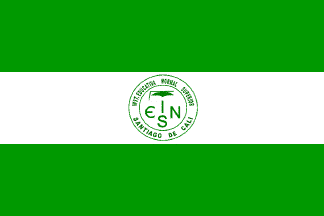
image by Ivan Sache, 6 January 2009
"Institución Educativa Normal Superior Santiago de
Cali" was founded on 12 February 1912 by the Assembly of the
Department of Valle del Cauca.
The flag, as shown graphically on the website
of the institute, is horizontally divided green-white-green
with the emblem of the institute in the middle.
Ivan Sache, 6 January 2009
Faculty of Law and Political Sciences

image by Ivan Sache, 25 December 2002
Faculty of Law and Political Sciences, University Santiago of Cali - The image of the flag, shown
without comments on the aforementioned website, is a bit
problematic. The flag is made of three horizontal stripes,
blue-white-green, and a vertical pink stripe is placed along the
hoist. The overall proportion of the image is 100:222, but
excluding the vertical stripe, we have a 1:2 flag! The colours
seem also to be weird, especially the pink, but they are derived
from the University shield, which is shown with a blue field, a
green border and pink writings.
Source: <www.usaca.edu.co/derecho>,
located by Dov Gutterman.
Ivan Sache, 25 December 2002
"Institución Educativa Departamental 'Santiago
Pérez'", based at Zipaquirá, Department of Cundinamraca,
was recognized on 29 September 1975, as "Colegio
Departamental 'Santiago Pérez'", by the Department of
Cundinamarca (Decree No. 31054); classes started on 1 February
1976. The current institute was formed on 30 September 2002
(Decree No. 3395) by the merging of "Colegio Departamental
'Santiago Pérez'", "Jardín Infantil 'Carrusel'"
and "Colegio Básico Portachuelo"
The flag of the institute, according to photos taken in 2008 and
the description available on the website of the institute, is
horizontally divided light blue-yellow-red (1:2:1) with the
emblem of the institute in the middle of the yellow stripe.
The flag and arms of the institute were approved by the Rector on
5 August 1976 - but the flag is subsequently said to have been
designed by teacher Fabio Restrepo Parra in 1977!
The colours are the same as on the flags of Colombia and
Cundinamarca. Blue represents the celeste heavens and the
crystalline waters of Zipaquirá. Yellow represents the resources
of the soil, as gold mined by the first inhabitants and local,
modern agriculture based on wheat cropping. Red represents the
"torrents of blood" shed by the local martyres for
peace, independence and liberty.
The emblem of the institute is circular, emerald green to
represent the aspirations of the students and of the Colombian
youth and the natural resources of the mountains surrounding the
valleys of Zipaquirá, Ubaté and Chiquinquirá (that is,
emeralds). The interlaced letters "C",
"S", "P" and "Z" recall the name of
the institute "Colegio Santiago Perez Zipaquirá". The
white "Z" symbolizes the colonial, salt-mining town of
Zipaquirá. The extreme parts of the letters mark the four main
compass directions. The white ring surrounding the emblem
represents candor and purity of the inhabitants of Zipaquirá and
innocence of the students. "DPTO. DE CUNDINAMARCA" is
written in golden letters on the ring.
This is how the emblem appears on the flag photographied in 2008,
see for instance here.
The symbols'
page on the website of the institute shows three different
representations of the emblem, none of which exactly matches the
emblem actually used on the flag, and a graphic of the flag with
the most recent emblem, with letters "I",
"S", "P" and"Z" reflecting the new
name of the institute and the name of the department dropped from
the border. See also photo
gallery.
Ivan Sache, 7 January 2009